Sharlyn J. Lauby's Blog, page 72
February 7, 2021
Everything HR Needs to Know About Sentiment Analysis

We regularly talk about employee engagement being important. It’s good for employees because it makes them feel valued and connected to their work. It’s good for business because engaged employees are more productive and will stay. But trying to find out if employees are engaged can be hard.
It’s one of the reasons that organizations conduct surveys. Hopefully, the survey results will tell us what employees are thinking. The reason I say “hopefully” is because there are times when we let our human biases read too much (or not enough) into employee feedback. Ideally, organizations need an unbiased way to interpret survey results.
That’s where sentiment analysis comes in. Sentiment analysis is a technology that helps organizations understand employee comments. I had an opportunity to learn more about this during a demo of Workhuman’s Moodtracker product and asked Yi Chu, natural language processing manager at Workhuman if she would share some insights. Thankfully, she said yes.
What is sentiment analysis? To be specific, is it a form of Artificial Intelligence (AI) or is it more accurate to say it utilizes AI?
[Chu] It utilizes AI. Sentiment analysis is an application of natural language processing (NLP) techniques. NLP is an area of AI. Simply put, sentiment analysis uses NLP and machine learning techniques to analyze large volume of text feedback to detect positive or negative feelings and uncover underlying opinions.
Obviously, HR pros don’t want to get a degree in engineering to understand sentiment analysis and sell it to the organization. Can you share with us a workplace example of how sentiment analysis works?

[Chu] One example is that sentiment analysis can be applied to open-ended feedback of employee surveys to rapidly gauge the employee’s perception towards the organization and how they feel about work.
More advanced techniques, such as aspect-based sentiment analysis, can be further applied to pinpoint the topics or themes that are mentioned in the surveys to give a better understanding of the survey responses.
Many tools that use sentiment analysis will share the results in layman’s terms, so the results don’t require an analytics or scientist to understand the outcomes.
Since sentiment analysis helps organizations achieve greater insights, how does this differ from and complement existing feedback tools like employee surveys?
[Chu] Sentiment analysis complements existing feedback tools, it’s not a stand-alone solution. Analyzing qualitative data (i.e., open-ended responses) manually is extremely time consuming and subject to human bias. Utilizing sentiment analysis provide a rapid and systemic way to analyze the data automatically. The analysis is consistent, real-time and easily scalable to large volume of data over time.
To properly understand others in our everyday face-to-face conversations, we have to “read” the other person’s body language, tone, etc. How does sentiment analysis take into account things like culture, slang, etc.?
[Chu] Sentiment analysis looks at text or verbal data so it will not take nonverbal communications into consideration. Yet sentiment analysis can be customized to take into account culture-specific language use or slang by adding the required into the model.
Generally speaking, you need a way to decode the context elements from your data and factor that into the modeling process. Using a survey as an example, you might want to add screening questions to collect the regions of the participants because regions and cultures are strongly correlated. Then region would be used as a variable in your sentiment analysis models when analyzing the survey results.
For organizations considering sentiment analysis, what are 2-3 things they should keep in mind?
[Chu] At the end of day, current machine learning algorithms are not perfect and struggle with interpreting the complexity of human language such as sarcasm, jargon and mixed opinions. Companies that are thinking about using sentiment analysis will want to do these things:
Design open-ended questions in a different way in order to make sure you get genuine feedback from employees. Open-ended are better at soliciting genuine feelings from survey participants than structured questions.Use the result of sentiment analysis as a reference instead of a dominating factor. Use the results but don’t let them be the ‘end all, be all’. Run surveys more frequently and apply sentiment analysis on a large pool of employees, since large data sets provide a more accurate and less biased analysis. While there is no standard on how often to run surveys, organizations might want to avoid annual or one-shot surveys because having a regular cadence of surveys scheduled is beneficial.I want to extend a huge thank you to Yi for helping us understand sentiment analysis. If you want to learn more, be sure to follow the Workhuman blog for more insights. Or watch a demo of Moodtracker to see how sentiment analysis can be used in a workplace setting.
Right now, organizations are trying to figure out the best way to deliver a human experience to their employees. Because they know that creating a more human work environment is good for the employee, the customer, and the bottom-line. Tools like sentiment analysis can help organizations understand what employees want and need.
P.S. If you’re looking for more information about how HR Technology can change your organization, be sure to check out the Spring HR Technology Conference & Expo. This FREE – VIRTUAL – event will be held March 16 – 19, 2021. It’s preapproved for SHRM and HRCI recertification credits. Registration details can be found on their website.
Image captured by Sharlyn Lauby at the 2018 Workhuman Conference in Austin, TX
The post Everything HR Needs to Know About Sentiment Analysis appeared first on hr bartender.






February 4, 2021
How to Measure Management Team Morale – Ask #HR Bartender

I really love today’s reader question because it talks about manager morale.
I am looking for some suggestions on how to measure the morale of management members and report in a graphical fashion. Thank you!
We often talk about employee engagement, satisfaction, and morale. And those things are important. But they’re predicated on manager engagement, satisfaction, and morale. It’s really hard – almost impossible – to have a highly engaged workforce with a disengaged manager. Granted a manager could be faking it really well (and that has happened), but eventfully employees figure it out. They’re smart.
So, putting measures in place to understand how engaged your management team is makes sense. Here are a few things to consider:
Create a manager onboarding program. Organizations have employee onboarding programs so new hires are set up for success. New managers need to be set up for success as well. During onboarding, check-in with managers to make sure they are getting the resources and support that they need. Organizations can do electronic check-ins and report the results in pie charts.
Conduct one-on-one meetings with managers. We ask managers to conduct one-on-one meetings with employees to discuss performance, offer coaching, and receive feedback. Senior leadership could do the same thing with managers. Or maybe HR can conduct manager one-on-ones annually? It might be a challenge to report the results in a graph, but a summary of findings could be very valuable.
Develop a survey. I’ve worked for companies that, during our annual employee engagement survey, we identified management (versus employees). This allowed the organization to see if there were areas where managers and employees felt differently. For example, the survey might show that managers were pleased with their benefits package, but employees weren’t. Or employees were happy with work/life balance, but managers aren’t. This allows the organization to take appropriate action.
Ask during exit interviews. While the manager has made the decision to leave, this doesn’t mean that the organization cannot collect some data about their work experience. Look at your current exit interview to see if you can add a couple of multiple choice or Likert scale questions. These can be reported in graphical fashion and trends can be identified over time.
One thing to note, it’s possible that the information you will gather during these activities is going to fall into a couple of categories. The first is what I’ll call trend data, meaning that it’s a trend you’re seeing with the manager group. For example, a lack of proper training. The organization can address the issue by creating learning opportunities.
The other type is individual data. It could be results that only apply to one person or a couple of managers. This might prompt an investigation. The results might find that there are some reporting relationship challenges. Or a manager is having some specific performance issues. The answer could be an intervention.
The good news is that many organizations already have the pieces in place to measure management engagement. They might need to figure out how to accurately pull the information from the larger data set. And as this reader mentioned, find a way to report the results so senior management will take action.
Image captured by Sharlyn Lauby while exploring the Wynwood Art District in Miami, FL
The post How to Measure Management Team Morale – Ask #HR Bartender appeared first on hr bartender.






February 2, 2021
The Future Workplace [Episode 1] – Recruiters Need Budgets to Source the Best Employees
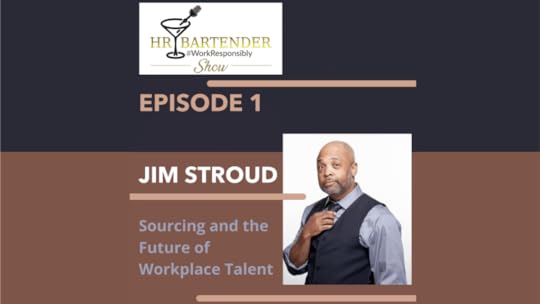
A few times in my career, I’ve been tasked with “turning around” or fixing HR departments. During those times, I’ve frequently come to realize that one of the departments’ biggest challenges was recruiting. Hiring managers were frustrated because they didn’t feel that the recruiters were sending qualified candidates in a timely fashion.
When the recruiting function suffers…everything in the business suffers. Organizations link their brands to talent. They build entire marketing campaigns around being able to deliver the best products and services. That begins with finding the best employees. So, I couldn’t think of a better person to start off our first season of The HR Bartender Show than Jim Stroud.
Jim is the vice president of marketing for Proactive Talent, a recruitment strategy consulting and staffing company specializing in recruiting optimization. He’s also a blogger, writer, and podcaster helping both organizations and job seekers find better ways to connect. Jim is the author of five (yes five!) books, and you can learn more about him at JimStroud.com. When he’s not online, he loves spending time with his family and searching for the best chocolate chip cookie. (And if you want to know his recommendation for the best chocolate chip cookie then you’ll have to listen to the show.)
Finding the best employees is and has always been a business priority. It starts with sourcing. But sourcing is more than simply conducting a whole bunch of Boolean searches. It’s about research, understanding business and hiring trends, as well as knowing the organization’s competition. When recruiters are equipped with the right data and information, they’re in a position to make sure candidates not only have a great experience but are offered employment opportunities that are fair, equitable, and competitive.
Connect with Jim Stroud
Email: jim@proactivetalent.com
LinkedIn: https://www.linkedin.com/in/jimstroud/
Twitter: https://twitter.com/jimstroud
During the show, Jim mentioned that Proactive Talent has an HR technology buying tool. So, if you are a recruiter, before you buy your next piece of HR technology (i.e. Phenom, Eightfold, Beamery, Symphony Talent) download their “Recruitment Marketing Platform Comparison Template.” It will prove invaluable as you evaluate potential HR tech vendors.
Thanks for listening to our podcast. This season of the HR Bartender show is brought to you by our friends at Ultimate Kronos Group (UKG), a leading global provider of human capital management, payroll, HR service delivery, and workforce management solutions.
You can subscribe to the HR Bartender show on Apple Podcasts, Spotify, Google Podcasts, Stitcher, and TuneIn. And we would absolutely love it if you would leave a review.
If you enjoyed this episode, be sure to check out other episodes on our podcast page.
Episode 1 – Jim Stroud Show Notes
Episode 1 – Jim Stroud Transcripts
The post The Future Workplace [Episode 1] – Recruiters Need Budgets to Source the Best Employees appeared first on hr bartender.






January 31, 2021
What HR Can Expect in 2021: Remote Work Norms

Estimated reading time: 4 minutes
I’ve mentioned before that I’m a fan of the curated electronic newsletter Morning Brew. They recently talked about trends for the year and mentioned remote work. It’s not a surprise. An increasing number of employees found themselves working from home during the pandemic. And organizations discovered that employees can be productive working from home.
As the author of the Morning Brew piece pointed out, “If the change a) made people’s lives better and/or b) saved the company money, we can reasonably assume some form of the behavior will stick around.” I believe that’s exactly what’s happening with remote work.
The article also pointed out one other thing that’s important. There’s a difference between working from home and remote work. Right now, most of us are working from home. For those employees who can do it, that’s great. It reduces exposure risk. Remote work is different. Remote work is about working somewhere other than the “office” or where you’re typically assigned to work.
For example, I typically work from home. If I were to spend the day at a client site, that’s remote work for me. For someone else, they might work in an office environment and spend a day working remotely from home. This distinction might matter when it comes to creating and updating company policies, procedures, and workflows.
The good news is many of the skills that employees use to be effective and productive when they work away from the office environment are the same ones that they will use when working remotely. As we start the New Year, here are a few articles that might be helpful in keeping our remote working skills current.
Working from Home Version 2.0: 5 Things to Consider
Home is quickly becoming the new workplace. Last year, when we were talking about working from home lasting a few weeks, we might have said to ourselves that we can make sacrifices if necessary. The longer this situation lasts, the more we need to consider a longer-term solution, especially in terms of your office set-up. Think of it as “Working from Home Version 2.0”.
Working from Home 2.0 – 5 Skills for Success
Work skills may change in the new Working from Home 2.0. We can set up the best home office ever and, if we don’t use it well, then we won’t see the results. Having the right work from home skills is the second part of the equation. If your organization is saying that you can work from home for the foreseeable future, think about those skills that you will need to work on and how you start training yourself to get better at them.
The Pros and Cons of Working from Home
Managing home and work demands can be a real balancing act. Employees want to be successful at telework, but managers need training for it. Define the parameters. Both the employee and employer need to agree on why you’re giving remote work a try, what’s expected in terms of manager and employee performance, and what will happen if expectations aren’t met. Open communication is essential.
Remote Job Search: Candidates and Recruiters Need to Plan Their Video Background
Remote video calls are adding a new wrinkle to job search. There are advantages to your video background showing that you are professional, organized, and well-read. These are qualities that you might mention during the interview and your video background backs it up. The downside is that depending on the background, biases can creep in. What if there’s a book from a controversial author in the background? Or a piece of art that someone might find offensive? And the pros/cons aren’t simply on the candidate side. A recruiter working remotely has to think of the same things.
Improve the Employee Experience by Providing Answers
The employee experience drives engagement and retention. HR departments have the opportunity to take a cue from their marketing counterparts and create employee experiences – using self-service technology – that resemble the customer experience. The good news is most employees are customers (somewhere), so the adoption rate should be significant, which brings immediate value to everyone involved.
I’m not sure exactly how many employees will continue working from home as more vaccines are distributed. I do know that commercial real estate is expensive, and organizations might be looking for ways to reduce expenses in 2021. That could translate into more employees having the option to work remotely.
Organizations and employees will want to take some time to figure out what remote work means for their organization. I don’t believe that remote work will be successful if it’s managed by exception. Remote work norms should be identified and communicated so performance expectations can be met.
Coming Soon to The HR Bartender Show
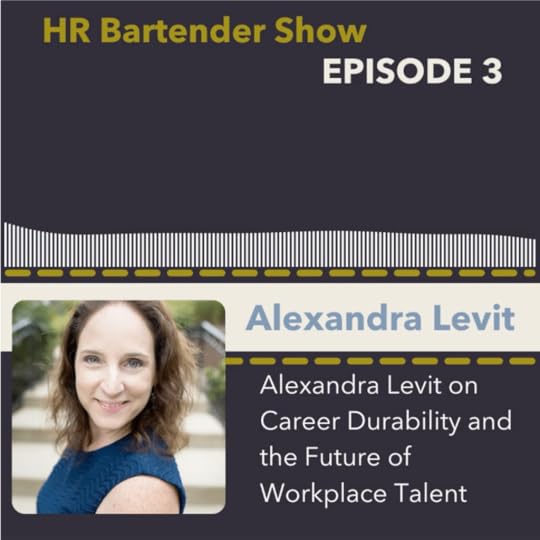
The post What HR Can Expect in 2021: Remote Work Norms appeared first on hr bartender.






January 28, 2021
Managing Personality Conflicts – Part 4 Self Management Series
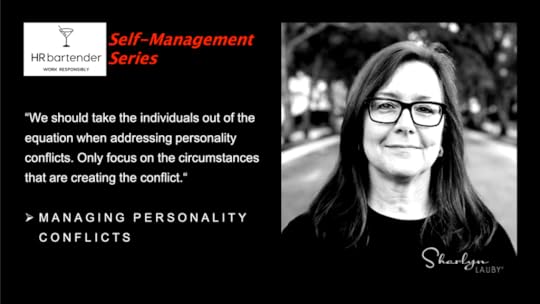
In part three of this series on self-management for remote workers, we talked about the need to be problem solvers. But what happens if the “problem” is another person? Well, that’s the fourth competency of self-management: being able to handle personality conflicts.
While working remotely can be great in terms of reducing the amount of time we spend with annoying co-workers, it doesn’t completely eliminate it. Even when we’re working remotely, we have to collaborate with people we may not like. And, we still need to be able to do it effectively.
When we work in a traditional office environment, we can rely on there being someone around who can help us resolve conflicts. Whether it’s our supervisor or human resources, they can facilitate a conversation and hopefully assist in reaching a resolution. In a virtual or autonomous environment, we have to resolve these personality conflicts on our own.
One way to examine personal conflict situations is to take the “person” part out of the equation and focus on the circumstances creating the conflict. This doesn’t mean we shouldn’t make sure the other person knows that having a good working relationship is important. Ask for their help in trying to reach a solution everyone can live with. Then examine the circumstances creating the conflict. In my experience, I’ve found the conflict often includes one of these three scenarios.
Conflict #1 – We don’t agree with the data.
In situations where the conflict is created because people can’t agree with the data, research and information, the best way to solve it is with more research. For example, Jane and John have a conflict. John believes the data from XYZ is correct and Jane believes the information from ABC is more accurate. This can create personality conflicts in the forms of distrust in each other or thinking that the other person isn’t doing enough work. By engaging in more research, they can hopefully find a common research source that they can both rely upon.
Conflict #2 – We don’t agree on the goal.
When the conflict surrounds goals and objectives, the way to resolve the conflict is with negotiation and compromise. Using our example above, John and Jane can’t agree on the desired outcome for the project. Both of them are frustrated and start to believe there are office politics or hidden agendas involved. By working together on a compromise, they are both able to have a say in the final goals of the project. Think win-win instead of a zero-sum game.
Conflict #3 – We don’t agree on the action.
Lastly, if the conflict is regarding the work that needs to be done then consensus is the means to conflict resolution. John wants to do Plan A and Jane would prefer to do Plan B. John and Jane should use their research (fromnumber one) and compromise (from number two) to create an outcome they can both live with. Notice I didn’t say they both needed to love it. That’s not the purpose of consensus. Consensus is about finding a solution all parties can live with.
As you can see, a key component to resolving conflict is understanding ourselves. When we can use the information we know about ourselves to step outside of conflict, we can begin a dialogue and work toward resolving the matter.
Speaking of knowing ourselves, our next self-management skill deals with something we don’t spend nearly enough time talking about…and that’s understanding how we like to learn.
The post Managing Personality Conflicts – Part 4 Self Management Series appeared first on hr bartender.






January 26, 2021
Education Benefits Must Work For a Hybrid Workforce

(Editor’s Note: Today’s article is brought to you by our friends at Bright Horizons, which manages over $600 million in annual talent investment through Bright Horizons EdAssist Solutions. Bright Horizons is a supporter of the CARES Student Loan Repayment Provision, which the U.S. Congress has extended to 2025. Enjoy the article!)
Over the past few years, employers have been really worried about an employee skills gap, especially in the area of technology. The pandemic has only accelerated this issue, with many reports showing the pace of digital transformation moving even faster now than before.
And yet there’s another, perhaps bigger, concern. Organizations know they need to educate their workforce to keep up with transforming skills, but they also need to do it in a way that reaches the new hybrid workforce (i.e. some in-office and some remote employees). Education programs have to be able to deliver the skills that organizations need with modern learning styles and in a way that doesn’t involve a centralized location.
That last part – about meeting employees where they are – is going to be extra important. Remote work is the default setting for many employees. There’s a reason it ranks on Bright Horizon’s e-book of essentials to future-proof your workforce. Not only do three-quarters of senior leaders at PwC say remote work is here to stay, almost as many at KPMG are actually downsizing office space. Google went as far to put the hybrid workforce model on paper as the policy for the company’s return to the office later this year.
Another reason for organizations to pay close attention: education assistance benefits remain an employee priority. We already know job candidates look for these benefits. We also know a big reason that employees stay with an organization is because they see career growth potential and feel the organization is invested in their success. And career growth spells confidence. With the hybrid workforce, organizations are going to have to reassure all employees that they can still reach their career goals, regardless of where they’re located.
To do all that, HR departments and management teams will have to look carefully at their current education benefits to make sure it meets the needs of a hybrid workforce. Here are five considerations that should be part of an education benefits review:
Evaluate what the organization currently offers: Review the education benefit to ensure that the program’s goals and implementation align with company culture and the evolving employee experience. Look at notes from exit and stay interviews for feedback.
Enhance online learning options: Remote working has increased comfort with online learning. Talk with your benefits partner to confirm that educational benefits include online colleges and universities and newer, innovative online learning programs such as MOOCs (massive open online courses) which offer a certificate for a small fee.
Communicate: Managers need to be up to speed on the program details so they can remind employees about the benefit and answer basic questions during one-on-one meetings and performance conversations.
Ensure information is easy to access: Program details and FAQs should be easily searchable on your company intranet. If your organization has employee self-service or an internal help desk, ensure information can be found there as well.
Talk it up: Make sure you’re including education benefits in recruitment marketing. Let candidates know what the organization offers and encourage recruiters and hiring managers to mention it during interviews.
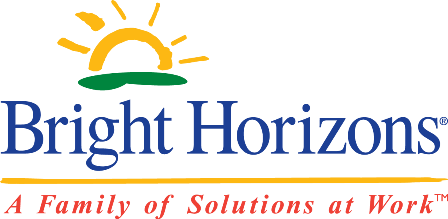
As organizations plan for the future, workplace flexibility will be at the center of the employee experience. Hybrid workplaces might not be forever, but my guess is it will be around for a while. And the key to delivering a successful employee experience is going to require benefits, policies, and procedures that work whether you’re in the office or working remotely.
If you want to learn more about aligning your education benefits with company culture, download the Bright Horizon’s ebook, “Future-Proofing Skills: 5 Essentials for Your Workforce Education Strategy”. It’s an excellent read you’ll want to share around the (virtual) office.
The post Education Benefits Must Work For a Hybrid Workforce appeared first on hr bartender.






January 24, 2021
What To Expect in 2021: Employee Driven Career Development

During the Great Recession, employers adopted the philosophy that employees needed to own their career development. Honestly, I think employees liked it. They were in charge of their learning and as a result, organizations adopted learning activities such as microlearning, social learning, and more self-directed learning.
Now that more employees are working remotely, I believe we’re going to see a greater level of employee driven career development. Learning doesn’t stop when you work from home. But organizations are going to want and need employees to offer some direction in terms of what remote learning looks like. Not only the best way to deliver remote learning but the topics that employees might find valuable.
Over the last year, we’ve written about some of the skills that employees should be developing. If you’re an employee, you might find these helpful in setting your goals for the year. And if you’re an employer, this could be a discussion starter about the content to offer.
6 Career Development Activities that Organizations Should Consider
Even though the focus of today’s article is on employee driven career development, organizations that are focused on employee engagement and retention need to consider career development as part of their strategy. Employees want to know that they have a future with the company they work for and part of that means knowing that the company is going to help them accomplish their career goals.
But career development is a broad term. It takes more than one program to create valuable and relevant development opportunities. I’m using the word relevant because career development isn’t just for employees. Career development helps organizations with future staffing needs.
How to Figure Out the Next Step in Your Career
Years ago, I was asked (along with a few other people) to come to the local unemployment office and provide some advice to individuals who had their jobs eliminated and were considering entrepreneurship as their next career. The conversations were exactly what you would expect. We were answering questions about how we became consultants, our biggest challenges, etc. In fact, it was very similar to the process I followed before becoming a consultant.
The reason I’m sharing this story is because a lot of the people who were trying to figure out if consulting was right career move for them were really struggling with the decision. What they really wanted was someone to answer the question: “Do I focus on trying to get a job inside a company or do I focus on starting my own company?” It’s a big decision and one everyone needs to make on their own.
Career Development: 5 Activities You Can Do Today
Right now, many of us are concerned about our career. Maybe you’ve been furloughed or laid off. Maybe you’re still working but are starting to hear rumors. Or maybe you’ve been thinking about making a career change for several months. Regardless of your situation, you should be thinking about your career and how to position yourself for opportunities.
There’s a saying in recruiting, “Always be closing.” Well in career development it’s “Always be ready.” As in, “Always be ready for your next opportunity.”
5 HR Skills You Should Be Developing Right Now
At one point in my career, I worked for an outplacement consulting firm. Part of the company’s role was to help individuals who were laid off find new opportunities. While some people were very upset about losing their jobs, others used the situation to pivot to a career they’ve been wanting to do for a while.
Whether you’re looking for a human resources or managerial role, having HR related skills is important. This article outlines a few skills beyond the usual recruitment, training, and employee relations.
Career development is about the organization and employees working together to identify learning opportunities. There’s no rule that says managers have to tell employees what to learn. And there’s also no rule that says all learning must happen in the office. Use this as an opportunity to build a career development plan that meets both employee and employer needs.
COMING SOON TO THE HR BARTENDER SHOW
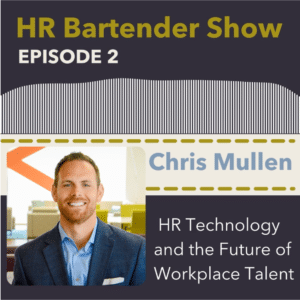
Image captured by Sharlyn Lauby while exploring the streets of Gainesville, FL
The post What To Expect in 2021: Employee Driven Career Development appeared first on hr bartender.






January 21, 2021
Front Loading Paid Time Off: Pros and Cons – Ask #HR Bartender
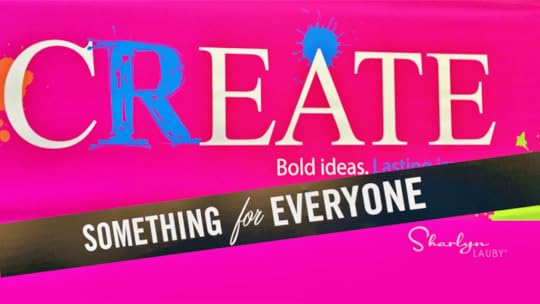
Many organizations are reevaluating their employee benefits offerings in light of the pandemic. With more employees working remotely, companies are looking at the benefits they offer in a physical office environment versus the ones that are able to be utilized virtually. They’re also looking at how employees are able to take time off. That’s the focus of today’s reader question.
Hello. My company is headquartered in Virginia and plans to switch to front-loading paid time off (PTO) at the beginning of 2021 to reduce some of the administrative burden that comes with traditional PTO policies and create a new benefit for our employees.
I feel as though front-loading is a newer PTO concept, and I’m having a hard time finding some legitimate information on it online. I have some slight concerns such as, how we would appropriately address PTO payouts (payouts are currently based on length of service), as well as what to do about employees who use all of their PTO at the beginning of the year, and then leave the organization.
What are your thoughts on front-loading policies, what pros and cons do you see that you think we should consider? Thank you for any assistance you can offer!
I’m not sure we can address everything about paid time off, but I did think this note was a great opportunity to talk about front loading paid time off (PTO) and why organizations might or might not want to implement it. To help us understand more about front loading PTO, I reached out to Steve Boddy, CCP, one of the total rewards subject matter experts at WorldatWork. We recently shared some survey data from them about what individuals expect in the employee experience. If you haven’t checked it out, you’ll find it an interesting read.
Steve, thanks for being here. Let’s start with a definition. What is front-loading PTO?
[Boddy] Front-loading PTO is a time off benefit program/policy that awards an amount of time (typically hours) for each employee at the beginning of each year (either calendar or fiscal). Time is also generally awarded on a pro-rated basis for new hires.
An example would be an organization that wants employees to have roughly 3 weeks paid time off a year to cover vacation, sick, and personal time so they award each employee 120 hours of PTO on January 1 of each year.
How does front loading PTO differ from a traditional PTO policy and/or unlimited Paid Time Off?

[Boddy] Traditional PTO policies generally use an accrual methodology. This method allows employees to earn or accrue a certain amount of PTO per pay period and employees build up a bank of PTO over time. In the example above, if the same organization had 24 pay periods, an employee would accrue 5 hours per pay period (160 hours / 24 = 5).
Unlimited PTO is another paid time off policy increasing in popularity, especially for exempt employee populations. This method allows employees to take as much time as needed each year without regard to PTO balances. It’s typically up to each employee’s manager to monitor and calibrate employees who are either not taking off enough time or are taking too much.
It sounds like one of the key differences in PTO, front loading PTO, and unlimited PTO plans is how they are applied to the financials/balance sheet.
[Boddy] Correct. Accrued or traditional PTO is an accrued liability on the balance sheet as it is earned. If an employee leaves, cash out of earned but not used time is required in most states. With front loaded PTO, there’s full liability on the balance sheet the day the PTO is granted. If an employee leaves, then the company will typically complete a full cash out (as required in most states). Lastly with unlimited time off, there’s no accrued liability on the balance sheet and it’s not cashed out upon termination.
Please note that the results of the recent WorldatWork 2020 Inventory of Total Rewards Programs & Practices (December 2020) indicated that 12% of participating companies now offer unlimited paid time off programs.
Now that we know what front loading Paid Time Off is, why would an organization move to frontloading PTO policy?
[Boddy] There are several factors that employers take when considering this type of policy.
It is very attractive to employees and can differentiate the employer when recruiting talent.It is easy to communicate to the employee population and easy to understand.Employees and new hires have the luxury of taking significant paid time off at the beginning of the year. For example, if an employee wants to take 2 weeks off in January for a ski vacation, this would be fully paid under a front-loaded PTO policy. Under an accrual policy, some or all this time off would either be unpaid, borrowed from future accruals, or not approved by the employee’s manager.Please note, an accrual plan may be considered easier operationally because the benefit is earned/managed as work is performed vs. providing a ‘vested’ benefit upfront.
The reader note mentions that current PTO payouts are based on length of service. How could an organization address payout when transitioning to a front-loading PTO?
[Boddy] This would really depend on the culture of the organization, state law requirements, and the provisions of the new plan that is established. Possible options include:
Adding the front-loaded PTO amount to current PTO balance. This may result in an excessive unused PTO liability to the organization, but it is an option.Paying out the current accrued and unused PTO balances to each employee then front-loading the new amount so all employees would start fresh based on the new front-loaded PTO award schedule.When considering payouts, the ‘old’ PTO amounts would depend on state law and whether the full amount is payable under the employer’s policies. Generally, the employer could either roll it over to the new PTO, pay out the value of it, or preserve the existing ‘old’ PTO benefits as a separate paid leave bank that they can continue to use.
Last question. Is there something that an organization can do to reduce the risk of an employee taking all their Paid Time Off then leaving the organization under a front-loaded PTO policy?
[Boddy] Not really. This is the biggest disadvantage of front-loading PTO. However, there may be some solutions available, depending upon applicable state law and clear communication to employees on the organization’s policies in effect governing PTO benefits and use.
Other solutions (as permitted by applicable law) may include capping the amount of PTO payout in the event of separation or implementing a waiting period to use front-load PTO benefits. PTO use is also governed by an organization’s PTO approval and use policies in effect. Organizations should ensure their policy states that use of PTO is subject to management approval and operational requirements.
I want to extend a huge thanks to Steve for sharing his knowledge and expertise with us. Be sure to check out WorldatWork’s 2020 Inventory of Total Rewards Programs and Practices (mentioned above) as well as their website for current insights – they have a full section of pandemic planning and response resources.

Today’s reader note is very indicative of what’s happening right now in the workplace. Organizations are reevaluating the employee experience because the employee experience is changing. At some point, will we go back to everyone being in the office? Yeah, sure, maybe. But for now, organizations are having to manage a hybrid workforce and revisiting employee benefits is part of the process.
P.S. If you’re considering a change in employee benefits, you might find these two articles where I talk with attorney Samuel Hoffman with Foley & Lardner LLP helpful:
Consider the Implications of “Grandfathering” Employee Benefits
Considerations When Eliminating Employee Benefits
The post Front Loading Paid Time Off: Pros and Cons – Ask #HR Bartender appeared first on hr bartender.






January 19, 2021
Talent Acquisition: Allocate Time to Evaluate Your Process

Estimated reading time: 5 minutes
(Editor’s Note: Today’s article is brought to you by our friends at Criteria, a leading provider of pre-employment testing services. To learn more about how pre-employment testing can benefit your talent acquisition strategy, check out Criteria’s “Definitive Guide to Pre-Employment Testing”. I’ve found it to be a comprehensive guide that I keep handy all the time. Enjoy!)
One of the things that Mr. Bartender and I like to do this time of year is evaluate some of the things we’re doing and possibly make some changes. For example, a couple of months ago, I was very frustrated with our cable company. We had talked a few times about “cutting the cord” but never really felt good about the options. Then I asked some Facebook friends, and they made suggestions of alternatives to try. We took a couple of months to test out our options and get comfortable with the idea of turning in that cable box. The end result? We’ve found an option that works for us (and it’s a lot cheaper too!)
The reason I’m bringing this up is because it makes sense to do the same thing in business. The first quarter is often a great time to evaluate current processes and try out new options. Talent acquisition is a good example. Over the past few months, organizations have made some adjustments to their hiring processes, like video interviews, virtual onboarding, and remote work. It’s possible that when those decisions were made, the organization viewed the change as temporary. While there’s a lot of good news about vaccines, I’d like to think that we all realize the road to the “next normal” is going to take time. Maybe it’s time to make a longer-term commitment to those “temporary” changes.
Take a Proactive Look at Talent Acquisition ProcessesIt only makes sense for HR departments to look at their talent acquisition processes from a more proactive standpoint. Let’s take the three activities that I mentioned above.
VIDEO INTERVIEWS: When we were first faced with the pandemic, many organizations simply moved their screening and interviews to a video platform like Zoom or Skype. And there’s nothing wrong with that. Now, organizations should evaluate whether video will become a regular part of the process. And if so, what part?
I’ve heard from many organizations that video screening interviews are effective both in terms of resources and quality of candidates. And they’re considering making video screening a regular part of their hiring process. However, in-depth video interviews will only continue until it’s safe to have in-person interviews. HR departments making commitments to video should consider developing a one-sheet for candidates explaining details of how the video interview will work.
VIRTUAL ONBOARDING: Like video interviews, organizations made some quick decisions regarding onboarding. It’s possible that they cut out some portions of the program figuring they could simply do them later. Well, now several months have gone by and new employees maybe possibly probably haven’t received all the information they need.
Organizations have to provide employees with information they’ve missed and put plans in place to offer new hires a complete experience, even from afar. Examples might include recording some welcome videos and mini-training sessions for employees to watch. If the organization doesn’t have a buddy program, create a virtual buddy system. Maybe the organization can work with a local vendor to have a welcome box of goodies sent to the employee’s home, similar to the new hire breakfast or lunch.
REMOTE WORK: There’s a regular conversation happening right now about whether employees should be working remotely and how remote work impacts organizational culture. I think it’s a valid conversation. That being said, organizations still have to deal with employees and remote work. My prediction is HR departments will be managing a hybrid workforce for most if not all of 2021. Maybe even some of 2022…

The reason this aligns with talent acquisition is because organizations should be looking at job descriptions to make sure they accurately reflect both in-desk and remote work. Job openings should specify if a position is onsite or remote. Organizations might want to identify the knowledge, skills, abilities, and competencies that can be aligned with both in-desk and remote work – like curiosity, initiative, and trainability – and incorporate interview questions and assessments into their process.
Talent Acquisition Benefits the Bottom-lineThese three talent acquisition activities – video interviews, virtual onboarding, and remote work – can make a big difference in the candidate experience which in turn impacts the employee experience and productivity. Taking the time to evaluate each aspect doesn’t have to be a big lengthy chore. Just ask yourself the following questions:
What’s taking place now?
Realistically, what do you expect for the next 6-12 months? 12-18 months?
How would you like the process to look post-pandemic?
Then connect the dots from where you are to where you want to be. Similar to a traditional gap analysis. HR is able to offer a long-term proactive talent acquisition strategy that can be adjusted should the vaccine implementation progress faster (or slower) than expected. This gives the organization the ability to quickly reposition themselves in the market after a tough year.
Organizations need to build a good foundation for their recruiting efforts because it’s their employees who make a difference in business. This means having a proactive approach when it comes to finding the best talent, which is great to do when it’s slower or at the beginning of a calendar or budget year.
Of course, once you evaluate your recruiting process then you want to be able to put it to work. I hope you’ll join me and the Criteria team on Tuesday, January 26, 2020 at 10a Pacific / 1p Eastern for a webinar on “How to Find More Qualified Candidates in 2021”. If you already have plans, go ahead and sign up anyway to get the recording after. Look forward to seeing you then!
The post Talent Acquisition: Allocate Time to Evaluate Your Process appeared first on hr bartender.






January 17, 2021
Can Employers Require Employees to Take the COVID19 Vaccine

Estimated reading time: 6 minutes
I know we’re still in the early stages of COVID-19 vaccine distribution and we don’t have all the answers yet. But that doesn’t mean organizations shouldn’t start thinking about their position and policies in terms of the vaccine and their workforce.
Recently, I listened to a webinar from our friends at Foley & Lardner LLP about some of the things that companies should start thinking about. So, I asked Mark Neuberger, who was one of the speakers on the webinar, if he would share his insights. Mark has shared his knowledge with us before. This article about “All Employee Medical Information Isn’t Protected by HIPAA” is an excellent read.
Please remember that Mark has a regular full-time job being a lawyer and he’s doing this to give back to the profession. His comments should not be construed as legal advice or as pertaining to any specific factual situations. If you have detailed questions, you should address them directly with your friendly neighborhood labor attorney.
Mark, I know there have already been articles about this, but just to confirm, can employers require employees to take the COVID-19 vaccine as a condition of employment?
[Neuberger] As to private sector (non-governmental employees) the very general answer is YES.
Furthermore, there is a long history of the government mandating people to get vaccines such as before you send your child to school, people serving in the military, and certain classes of people wanting to immigrate to the United States. For years, many employers in high-risk workplaces (e.g., hospitals and nursing homes) have required their employees to obtain an annual flu vaccine.
But, before an employer decides it is going to make getting the COVID vaccine a condition of employment there are a number of legal and other considerations that must be considered.
Employers – particularly private sector employers – might have employees who need/want accommodations under the Americans with Disabilities Act (ADA) or for religious reasons. For employees who unable/unwilling to take the vaccine, are employers able to make adjustments to the employee’s position (i.e. work location, schedule, pay, etc.) to reduce the potential spread of the virus? Are they required to?

[Neuberger] Under Title VII of the Civil Rights Act and similar state and local anti-discrimination laws, an employer is required to make reasonable accommodations to qualified individuals with a disability and to individual’s religious beliefs and practices. If an employer were to mandate vaccines, they would have to go through an interactive process with the employee to determine if the resistance to the vaccine can be ‘reasonably’ accommodated.
One might say ‘What possible accommodation could be made to someone who might infect the workforce by not getting the vaccine?’ Here’s one idea: keep them working at home until herd immunity attaches to larger society which, if we are fortunate, could be sometime this summer. The Equal Employment Opportunity Commission (EEOC) has issued guidance which does say ‘if no reasonable accommodation is possible, then it would be lawful for the employer to exclude the employee from the workplace.’
If an employer requires an employee to take the vaccine (and the employee is fine with it too), is the employer obligated to cover the cost (if there are any)? If not, wouldn’t it be a best practice to do it anyway?
[Neuberger] Generally yes, the employer would have to, or should as best practice pay the costs, but this seems to be a moot point as the federal government has declared no one will have to pay for the vaccine.
Has there been any guidance to employers about vaccines and new hires? Meaning can an employer ask a candidate if they’ve received the vaccine and can they ask for proof.
[Neuberger] When people get the COVID-19 vaccine they are issued either a paper or electronic certificate of proof. The EEOC has said employers who ask a job candidate or employees ‘Did you get the vaccine?’ and if the answer is ‘yes’, then ‘Show me the proof.’, would be permissible inquiries.
The EEOC cautions that going beyond those questions by asking ‘Why not?’ is likely stepping into the prohibited zone of inquiry.
While they’re not employees, many organizations hire freelancers/contractors/consultants. Can an employer ask about vaccines and require proof as part of a contract?
[Neuberger] If they follow the guidance suggested above the answer is yes. Remember most, but not all anti-discrimination laws do not apply to independent contractors, only employees. Of course, that opens up an entirely new can of worms, namely are they really an independent contractor or has the employer misclassified them.
Hypothetically, if a contractor/candidate/employee misrepresents whether they’ve taken the vaccine, can an employer be held accountable/liable if an illness results?
[Neuberger] The answer to that question involves a very complicated legal analysis dependent in part on specific facts but the answer would likely come down to knowing if the employer acted negligently. If an employer adopts sound screening processes and a candidate or contractor lies and hides facts that could not otherwise reasonably be uncovered, that would not be negligence.

Last question. I’m sure there’s going to be a lot of guidance (and changing guidance) to employers over the next few months about vaccines. If there’s one thing that companies need to be focused on – what is it?
[Neuberger] I predict that in the next few months we may see new and different workplace laws. If COVID-19 continues to rage and if large segments of the population refuse to get the vaccine, I would not be surprised to see the feds or certain states and localities pass laws mandating the vaccine in certain circumstances.
As I mentioned earlier, there is a way to do it under the law and it’s been done before. Also, we will have a Democrat President, both houses of Congress controlled by the Democrats and if confirmed by the Senate, a Secretary of Labor (The nominee is Boston Mayor Martin J. Walsh.) who used to be a labor union official. So, my advice to the HR community is to fasten your seatbelts and tug on them twice to make sure they are tight because we are in for some turbulence.
A huge thank you to Mark for sharing the latest with us. Don’t forget that Foley & Lardner has a Coronavirus Resource Center to provide us with current information. And you might want to take a listen to their latest webinar focused on the labor and employment issues coming in 2021.
Mark is absolutely right when he says there’s a lot going on and HR pros need to get ready. We’re still dealing with COVID-19 and we have a new administration. Staying current with compliance will be valuable to our organizations and our employees.
P.S. Here are a couple of additional resources you might find helpful.
What You Should Know About COVID-19 and the ADA, the Rehabilitation Act, and Other EEO Laws (from the U.S. EEOC website, dated December 16, 2020)
EEOC Addresses COVID Vaccine Guidance and Potential Discrimination Issues (from the Foley & Lardner blog, dated December 16, 2020)
Image captured by Sharlyn Lauby while exploring the Wynwood Art District in Miami, FL
The post Can Employers Require Employees to Take the COVID19 Vaccine appeared first on hr bartender.






Sharlyn J. Lauby's Blog
- Sharlyn J. Lauby's profile
- 10 followers



